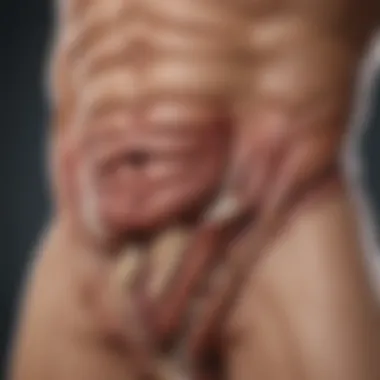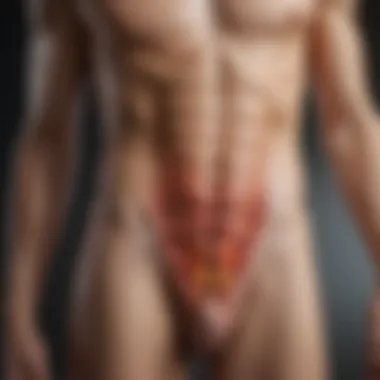Understanding Right-Sided Abdominal Pain: Causes and Care


Intro
Right-sided abdominal pain presents a complex medical challenge, often causing distress and concern for those experiencing it. Understanding the various causes of this pain is crucial not only for accurate diagnosis but also for effective treatment. The right side of the abdomen houses several vital organs, including the liver, gallbladder, appendix, and parts of the intestines. Each of these organs can be implicated in pain presentations, leading to a diverse spectrum of potential diagnoses.
In this article, we will embark on a thorough exploration of right-sided abdominal pain. We will examine the anatomy of the region, delve into common causes of pain, outline diagnostic procedures, and discuss potential management strategies. By providing clarity on the significance of related symptoms and the timing of onset, we hope to empower readers with knowledge to navigate this often confusing medical scenario.
Research Overview
Summary of Key Findings
As we delve into the research surrounding right-sided abdominal pain, it becomes clear that the underlying causes are manifold. Literature suggests that appendicitis, cholecystitis, and renal colic are among the most common causes. Each condition manifests through distinct symptoms and clinical presentations. For instance, appendicitis typically results in acute pain localized in the right lower quadrant, whereas gallbladder issues may present with intermittent pain in the upper right quadrant accompanied by nausea.
Methodologies Employed
Research methodologies used in studies about right-sided abdominal pain include retrospective analyses of patient cases, cross-sectional studies, and cohort studies. Utilizing imaging techniques like ultrasound and CT scans plays a pivotal role in identifying the root cause of the pain. Physicians often rely on these diagnostic tools to differentiate between various conditions and confirm a diagnosis.
In-Depth Analysis
Detailed Examination of Results
Upon examining the results from recent studies, the prominence of timely diagnosis emerges as a critical factor in managing right-sided abdominal pain. A significant number of cases exhibit a delay in diagnosis, primarily due to overlapping symptoms with other conditions such as gastroenteritis or peptic ulcers. This delay can lead to complications that worsen patient outcomes.
Comparison with Previous Studies
When comparing current findings to those of previous studies, a consistent theme is the value of comprehensive clinical evaluation. Many earlier studies highlighted the efficacy of physical examinations and patient history in guiding diagnostic decisions. However, emerging research indicates a growing reliance on advanced imaging techniques, thereby shifting the focus towards technology in contemporary medical practice.
"Recognizing the complexity behind right-sided abdominal pain can lead to more precise diagnoses and better treatment options."
Anatomy of the Abdomen
Understanding the anatomy of the abdomen is crucial for diagnosing right-sided abdominal pain. The abdomen houses many vital structures, each capable of causing pain if they become inflamed, infected or otherwise compromised. Knowledge of these anatomical elements not only assists in pinpointing the source of pain but also shapes the pathways for effective intervention.
Overview of Abdominal Regions
The abdomen is traditionally divided into four quadrants: right upper quadrant, right lower quadrant, left upper quadrant, and left lower quadrant. Each quadrant contains distinct organs and systems that are relevant to abdominal health.
- Right Upper Quadrant: Contains the liver, gallbladder, right kidney, and a portion of the pancreas.
- Right Lower Quadrant: Includes the appendix, parts of the small intestine, and portions of the reproductive and urinary systems in females and males, respectively.
This division is essential for medical providers. It allows them to narrow down potential causes of discomfort based on the location of the pain. Recognizing which organs correspond to specific quadrants aids in determining possible conditions such as appendicitis or gallbladder disease.
Structures in the Right Abdominal Quadrant
The right abdominal quadrant is home to several significant anatomical structures, pivotal for understanding potential causes of right-sided abdominal pain.
Key Structures:
- Liver: Responsible for detoxification, metabolism, and bile production, issues such as hepatitis or liver cirrhosis can lead to right-sided pain.
- Gallbladder: Stores bile that aids in fat digestion. Gallstones or cholecystitis result in acute or chronic pain on the right side.
- Right Kidney: Infections or stones in the kidney may present as severe pain in the flank region migrating to the lower abdomen.
- Appendix: Inflammation, marked by appendicitis, is a common cause of emergency pain in the right lower quadrant.
Notably: The interconnectedness of these organs means that dysfunction in one can impact others, complicating the diagnosis further. Each structure must be carefully considered when evaluating right-sided abdominal pain. Understanding the anatomical layout is foundational for any clinical assessment related to abdominal discomfort.
Common Causes of Right-Sided Abdominal Pain
Understanding the common causes of right-sided abdominal pain is essential for effective diagnosis and treatment. Right-sided pain can stem from various conditions, some of which may require prompt intervention. Early identification of the cause leads to better outcomes for patients.
Many anatomical structures reside in the right abdominal quadrant, including the appendix, liver, gallbladder, and right kidney. Pain originating from any of these organs can significantly influence the underlying diagnosis. Furthermore, symptoms associated with right-sided abdominal pain vary widely between individuals, making clinical evaluation crucial.
Appendicitis
Appendicitis is one of the most well-known causes of right-sided abdominal pain. It often arises suddenly and presents with localized pain in the lower abdomen. Initial pain may occur around the navel before migrating to the lower right quadrant. Alongside pain, symptoms can include nausea, vomiting, and sometimes fever. This condition is considered a surgical emergency because an inflamed appendix can rupture, leading to serious complications.
Gallbladder Disorders
Gallbladder issues, such as gallstones and cholecystitis, can also cause right-sided abdominal discomfort. Pain from gallbladder disorder is typically experienced in the upper right quadrant and may radiate to the shoulder or back. Patients often report episodes of intense pain following meals, especially if fatty foods are consumed. Other symptoms may include bloating, indigestion, and jaundice, which signals that a more serious condition could be present.


Kidney Stones
Kidney stones can lead to severe pain on the right side if a stone is lodged in the right kidney or ureter. This pain, known as renal colic, is often sharp and can move to different locations as the stone shifts. Additional signs can include hematuria (blood in urine) and frequent urination. The sudden onset of this type of pain typically requires urgent medical evaluation and may need surgical intervention if the stone is too large to pass.
Liver Conditions
Conditions affecting the liver, like hepatitis or liver abscess, can also be a source of right-sided abdominal pain. The liver's location in the upper right quadrant makes it susceptible to referred pain. Individuals might experience a dull ache or discomfort along with systemic symptoms like jaundice, fatigue, and malaise. Proper imaging and blood tests are essential for accurate diagnosis, guiding potential treatments.
Intestinal Issues
Various intestinal issues can contribute to right-sided abdominal pain. Conditions such as Crohn's disease or right-sided diverticulitis can cause inflammation and pain in the lower right abdomen. Patients may additionally suffer from changes in bowel habits or recurrent episodes of diarrhea. It is important to evaluate the presence of other symptoms and history to guide the diagnostic process effectively.
"A thorough understanding of the specific causes of right-sided abdominal pain is necessary to determine the correct diagnostic approach and management plan."
Recognizing the different potential causes underlying right-sided abdominal pain ensures that medical professionals can develop a targeted treatment strategy. Each condition has distinct characteristics, and a detailed clinical evaluation is fundamental to address this concern efficiently.
Pediatric Considerations
Pediatric considerations are critical when assessing right-sided abdominal pain. Children’s anatomical and physiological differences require a tailored approach. Often, abdominal pain in children can stem from various factors like infections, gastrointestinal disorders, and even stress. Understanding these factors is essential not just for diagnosis but also for effective management. Recognizing how pediatric patients communicate symptoms can differ from adults is crucial. Thus, parents and healthcare providers should work together in identifying potential issues, ensuring quicker and more accurate diagnoses.
Common Pediatric Abdominal Issues
Several common issues can lead to right-sided abdominal pain in children. Among them are:
- Appendicitis: One of the leading causes of acute abdominal pain. Children may show symptoms like vague abdominal discomfort, nausea, or vomiting.
- Intestinal Obstruction: This can occur due to various reasons, including intussusception, which often presents with severe abdominal pain and may accompany a currant-jelly stool.
- Infectious Diseases: Viral or bacterial infections can lead to abdominal pain, with gastroenteritis being a frequent cause. Young children often have difficulty pinpointing specific areas of discomfort.
- Urinary Tract Infections: They can sometimes manifest with abdominal pain, especially if the bladder or kidney is involved. Children may also have fever, dysuria, or frequent urination.
Understanding these issues helps in recognizing patterns and alerts clinicians to perform appropriate evaluations at early stages.
Differences in Presentation
The presentation of right-sided abdominal pain in children can vary significantly from adults. Several factors contribute to these differences:
- Communication Skills: Children may struggle to describe their pain clearly. This can lead to underreporting or misinterpretation of the severity of the symptoms.
- Pain Tolerance: Younger patients might exhibit different pain thresholds. Children may appear more agitated or withdrawn, complicating the assessment process.
- Associated Symptoms: Accompanying symptoms tend to differ. For example, a child with appendicitis may also experience changes in appetite or increased irritability, while an adult might express classic signs like guarding or rebound tenderness.
- Timeliness of Consultation: Parents may delay seeking medical help due to misconceptions about children's resilience or might initially attribute pain to less serious conditions. This can lead to complications if underlying issues are not identified and treated promptly.
Pediatric abdominal pain presents unique challenges for assessment and management. Awareness of these differences can enhance diagnostic accuracy and treatment outcomes.
Understanding these critical aspects enables healthcare professionals to adopt a more effective and considerate approach when diagnosing and managing right-sided abdominal pain in pediatric patients.
Differential Diagnosis
Effective differential diagnosis contributes to several key benefits:
- Targeted Treatment: Identifying the precise cause of pain allows for tailored management plans, which can significantly enhance patient outcomes.
- Prevention of Complications: Timely diagnosis aids in avoiding potential complications associated with delayed treatment, such as perforation in appendicitis.
- Resource Optimization: Focusing on specific diagnoses can help streamline the use of healthcare resources, reducing unnecessary tests and procedures.
Identifying Non-Gastrointestinal Causes
It is essential to consider non-gastrointestinal causes when evaluating right-sided abdominal pain. Such conditions can mimic gastrointestinal disorders, which may mislead the practitioner. Common non-gastrointestinal sources include:
- Renal Issues: kidney stones or infections can manifest as pain in the right lower abdomen.
- Pulmonary Problems: conditions like pneumonia may present with referred pain to the abdominal area.
- Gynecological Disorders: in females, ovarian cysts or ectopic pregnancies can cause pain that may be mistaken for gastrointestinal issues.
Clinicians should maintain a broad differential diagnosis to avoid clinical pitfalls. The presence of symptoms such as dysuria or irregular menstruation may hint at a non-gastrointestinal cause.
When to Refer for Imaging or Consultation
Determining when to refer patients for imaging or expert consultation is a critical decision in the diagnostic process. Factors influencing this decision include:
- Severity of Symptoms: Persistent or worsening pain may necessitate further investigation.
- Diagnostic Uncertainty: If initial evaluations do not clarify the cause, imaging can provide valuable insight.
- Clinical Instability: Patients presenting with signs of shock or severe illness should be expedited for imaging or surgical evaluation.
Common imaging techniques include:
- Ultrasound: Often the first step, especially in pediatric cases or in gynecology.
- CT Scan: Provides detailed images and is useful for diagnosing appendicitis or diverticulitis.
In these circumstances, timely collaboration with specialists such as radiologists or surgeons can greatly enhance diagnostic accuracy and patient care.
Proper differential diagnosis can save lives by guiding appropriate interventions in a timely manner.


Symptoms Associated with Right-Sided Abdominal Pain
Understanding the symptoms of right-sided abdominal pain is crucial in managing this condition effectively. The presentation can vary widely among individuals, leading practitioners to a spectrum of possible diagnoses. Recognizing specific symptoms helps narrow down potential causes, which can influence treatment options.
Pain Characteristics
The quality and location of pain greatly influence diagnostic outcomes. Patients may describe their pain in various ways, such as sharp, dull, or cramping. It is often important to ask about the onset of pain:
- Acute pain may suggest conditions like appendicitis or kidney stones.
- Chronic pain can be linked to issues such as gallbladder disease or irritable bowel syndrome.
Additionally, the radiation of pain can provide valuable clues. For instance, pain that radiates to the back might indicate pancreatic issues, while pain referring to the shoulder may signal liver complications. The timing of pain also matters; whether it occurs after meals, during physical activity, or at rest can lead to different diagnostic considerations.
Nausea and Vomiting
Nausea and vomiting are often associated symptoms of right-sided abdominal pain. These symptoms can indicate systemic responses to abdominal issues. When nausea accompanies abdominal pain, it heightens suspicion of gastrointestinal disturbances. In cases such as appendicitis, patients frequently report nausea preceding the pain. Conversely, vomiting may occur due to complications or infections that irritate the gastrointestinal tract.
Awareness of these symptoms is pivotal for medical professionals. They should consider the severity and frequency of nausea and vomiting to assess dehydration risks and the need for potential interventions.
Changes in Bowel Habits
Changes in bowel habits can further elucidate the underlying cause of right-sided abdominal pain. Clinicians should inquire about:
- Constipation or diarrhea, which can suggest various conditions, including inflammatory bowel disease or obstruction.
- Blood in the stool or mucus, which may signal more severe issues, possibly requiring immediate action.
Regular monitoring of these symptoms can facilitate earlier diagnosis and improve management outcomes. Patients experiencing significant changes in bowel habits alongside right-sided abdominal pain should seek medical evaluation promptly. Awareness and patient history in this regard are pivotal in timely intervention.
"Monitoring symptoms like pain, nausea, and bowel habits can significantly impact treatment decisions and patient care outcomes."
Diagnostic Approaches
Diagnostic approaches for right-sided abdominal pain are crucial in identifying the underlying causes of this symptom. Accurate diagnosis ensures timely treatment, which can be essential for preventing complications. Understanding the diagnostic methods—clinical evaluation, laboratory tests, and imaging techniques—can significantly impact patient outcomes. Each element plays a role in forming a comprehensive understanding of a patient's health status, thereby enhancing treatment efficacy and addressing concerns efficiently.
Clinical Evaluation
The clinical evaluation is often the first step in diagnosing right-sided abdominal pain. This process typically begins with obtaining a detailed medical history from the patient. It is important to ask about the duration of pain, its characteristics, and any accompanying symptoms. Key factors, such as prior medical conditions, surgeries, and medication use, provide insight into potential causes. The clinician may perform a physical examination, which involves palpating the abdomen to identify tenderness, rigidity, or any masses. Observations made during this examination can help narrow down the possibilities.
A well-conducted clinical assessment can direct the next steps in the diagnostic process. It helps to categorize the pain, distinguishing between acute and chronic patterns, and assessing the gravity of the situation. Specific indications may prompt the clinician to escalate to further tests or imaging studies to ensure a proper diagnosis.
Laboratory Tests
Laboratory tests serve as an extension of the clinical evaluation. They help uncover biochemical imbalances or infectious processes that may be contributing to abdominal pain. Common laboratory tests include:
- Complete Blood Count (CBC): This test can reveal signs of infection or inflammation, indicated by elevated white blood cell counts.
- Liver Function Tests: These tests assess liver health and can indicate dysfunction or damage.
- Urinalysis: Useful for identifying kidney issues or urinary tract infections, which can sometimes refer pain to the abdominal region.
- Electrolyte Panels: They check for imbalances that may contribute to abdominal discomfort, especially in patients with poor dietary habits or chronic illnesses.
Such tests help refine the differential diagnosis, guiding clinicians on whether further imaging or specialist consultation is warranted. The interpretation of laboratory results should be contextualized within each patient’s specific clinical situation for maximum effectiveness.
Imaging Techniques
Imaging techniques are essential tools in the diagnostic toolkit. They provide visual insight into the abdominal structures and can reveal abnormalities not detectable through physical examination or lab tests. Common imaging options include:
- Ultrasound: Often the first-line imaging choice for right-sided pain, it can visualize organs like the gallbladder and kidneys, looking for stones or inflammation.
- Computed Tomography (CT): This technique offers detailed cross-sectional images and is particularly useful for assessing appendicitis, abscesses, or tumors.
- Magnetic Resonance Imaging (MRI): Although less commonly used for acute abdominal pain, MRI can be valuable in certain scenarios, particularly for identifying soft tissue abnormalities.
These imaging modalities significantly aid the clinician in making a conclusive diagnosis. They not only help confirm suspicions arising from clinical evaluations but also assist in the early detection of potentially serious conditions.
"A thorough diagnostic approach is critical. Early identification can lead to a more effective treatment pathway."
In summary, the diagnostic approaches to right-sided abdominal pain involve a systematic evaluation of the patient. Clinical evaluations lay the groundwork, while laboratory tests and imaging techniques build on these findings. Together, they create a robust framework for understanding abdominal pain, facilitating accurate and timely interventions.
Management Strategies
Management strategies are crucial when addressing right-sided abdominal pain due to the various underlying conditions that can manifest with this symptom. Proper management helps in alleviating pain, improving the quality of life, and preventing complications. Effective strategies encompass both medical and surgical approaches, tailored to the specific diagnosis and individual patient needs.
Medical Management
Medical management primarily focuses on conservative treatments aimed at symptom relief and addressing the underlying cause. In cases of right-sided abdominal pain, medication may play a vital role. Commonly used medications include:


- Analgesics: These help in reducing pain. Non-steroidal anti-inflammatory drugs (NSAIDs), such as ibuprofen, are often used.
- Antibiotics: In cases of infection, such as appendicitis or diverticulitis, antibiotics can be critical to control bacterial growth and prevent escalation of the condition.
- Antispasmodics: For conditions involving muscle spasms in the gastrointestinal tract, antispasmodics can relieve discomfort.
In addition to medications, lifestyle management is also essential. This includes dietary changes, hydration, and regular exercise to optimize digestive health. Educating patients on recognizing warning signs and when to seek further medical evaluation is also a key aspect of management.
Surgical Approaches
In situations where medical management fails, or if there is a significant risk of complications, surgical intervention may be necessary. Surgical approaches may include:
- Appendectomy: The surgical removal of the appendix is performed when appendicitis is diagnosed. This is a common procedure and typically resolves the acute pain.
- Cholecystectomy: If gallbladder disorders are present, such as cholelithiasis, removing the gallbladder can alleviate pain and prevent further complications.
- Exploratory Laparotomy: In some cases, especially when the cause of the pain is unclear, a laparotomy may be necessary to visualize the abdominal organs directly and provide a diagnosis.
It is important to weigh the benefits and risks of surgical procedures. A thorough preoperative assessment helps ensure that the selected approach aligns with the patient's overall health and specific condition. Post-operative care is equally important, as it plays a crucial role in recovery and addressing any potential complications.
Key Insight: Immediate management of right-sided abdominal pain can significantly influence patient outcomes. Identifying the cause accurately can lead to effective treatment strategies, whether medical or surgical.
Potential Complications
Understanding the potential complications associated with right-sided abdominal pain is crucial. These complications can significantly affect the outcome and management of the underlying conditions. Recognizing these complications early can lead to timely interventions, which can minimize risks and improve overall patient care.
One significant concern is the delay in treatment. A delayed response to right-sided abdominal pain can lead to serious outcomes. Many serious conditions, such as appendicitis or gallbladder issues, require prompt surgical intervention. An undue delay can result in perforation of organs, leading to abdominal infections or peritonitis, which is a severe and potentially life-threatening complication. Monitoring changes in symptom severity, alongside prompt medical attention, is essential to mitigate this risk.
Additionally, there are chronic pain syndromes that can arise as a result of untreated or improperly managed right-sided abdominal pain. Ongoing pain can persist even after the initial cause is resolved. This persistent pain can lead to functional impairment and a reduced quality of life for patients. Understanding the relationship between acute right-sided abdominal pain and the potential for chronic pain syndromes is important. Taking an adequate medical history, conducting thorough evaluations, and developing a comprehensive treatment plan are all vital steps in preventing these complications.
"Complications arising from right-sided abdominal pain must not be underestimated; early recognition and intervention are essential for preserving patient health."
In summary, recognizing the potential complications associated with right-sided abdominal pain is key. Both delay in treatment and chronic pain syndromes present significant challenges that require careful thought and management. Addressing these issues can greatly influence the prognosis and recovery of patients.
Preventive Measures
Preventing right-sided abdominal pain involves addressing several lifestyle factors and encouraging proactive health management. The significance of preventive measures in this context lies in the ability to reduce the incidence of conditions that can lead to such pain. Being informed and engaged in one’s health can minimize risk factors associated with various diseases, particularly those affecting the gastrointestinal and urinary systems.
Lifestyle Considerations
Healthy lifestyle choices play a crucial role in preventing right-sided abdominal pain. Here are some vital elements to consider:
- Balanced Diet: A diet rich in fiber can help maintain healthy bowel function and prevent conditions like diverticulitis, which may result in pain. It’s beneficial to include fruits, vegetables, whole grains, and lean proteins while limiting processed foods and sugars.
- Regular Exercise: Engaging in regular physical activity can aid in digestion and prevent obesity, which is a risk factor for gallbladder disease and other abdominal problems. Aim for at least 150 minutes of moderate exercise each week.
- Hydration: Adequate fluid intake is essential. Drinking enough water can help prevent kidney stones and urinary tract infections, both of which can cause pain in the right abdomen.
- Avoid Smoking and Limit Alcohol: Smoking can increase the risk of various abdominal conditions, while excessive alcohol consumption can damage the liver. Avoiding both can significantly lower risks.
By making these adjustments, individuals contribute to their overall well-being and potentially decrease their chances of developing serious abdominal issues.
Regular Health Check-Ups
Routine health check-ups are vital for early diagnosis and management of potential health risks. Here’s why prioritizing these appointments is necessary:
- Early Detection: Regular check-ups can catch diseases in their early stages. Conditions like appendicitis or gallstones may develop without immediate symptoms. Regular evaluations can identify them before they progress to severe pain.
- Monitoring Existing Conditions: For individuals with known health issues, consistent check-ups facilitate monitoring and adjustments to management plans. This could involve dietary recommendations or medication adjustments related to liver or kidney functions.
- Blood Tests and Imaging: Regular tests can screen for various conditions that may not show symptoms initially. Blood tests can indicate liver function, while imaging techniques like ultrasounds can evaluate gallbladder or kidney health, contributing to timely intervention.
- Patient Education: Check-ups provide a platform for healthcare providers to educate individuals on risk factors associated with abdominal pain, empowering them to take proactive steps.
Establishing a routine for health check-ups not only improves individual health but also contributes to longer-term well-being. By integrating lifestyle considerations and regular health assessments into daily life, individuals can reduce their risk of experiencing right-sided abdominal pain significantly.
"An ounce of prevention is worth a pound of cure."
Emerging Research and Trends
Emerging research and trends in the field of right-sided abdominal pain are essential for advancing both diagnostic capabilities and treatment methodologies. As understanding of the human body improves, researchers are exploring various approaches to refine the assessment of abdominal pain. This section will focus on innovations that are enhancing diagnostic techniques and advancing treatment options.
Innovations in Diagnostic Techniques
Modern advances in imaging technologies have significantly improved the accuracy of diagnosing right-sided abdominal pain. Techniques such as magnetic resonance imaging (MRI) and high-resolution ultrasound have become essential in identifying underlying conditions. These methods provide clearer, more detailed images of internal structures.
In addition, the integration of artificial intelligence in radiology is transforming the way images are analyzed. AI can detect patterns that may be overlooked by human eyes, leading to earlier and more precise diagnoses. Moreover, the utilization of biomarkers in conjunction with imaging studies aids in differentiating between causes of abdominal pain more effectively.
The combination of traditional diagnostic methods with innovative technologies is enhancing the understanding of abdominal disorders.
These advancements not only increase diagnostic accuracy but also enhance patient safety by reducing the need for invasive procedures. As these innovations continue to develop, their implementation in clinical practice will likely become standard, thereby improving patient outcomes.
Advancements in Treatment Options
Just as diagnostics are evolving, treatment options for right-sided abdominal pain are also seeing significant advancements. Minimally invasive surgical techniques, such as laparoscopic surgery, are now preferred for conditions like appendicitis and gallbladder disorders. This approach reduces recovery time and minimizes complications compared to traditional open surgery.
Furthermore, the use of targeted therapy for liver and kidney conditions is gaining traction. Medications addressing specific biochemical pathways related to pain and inflammation are being researched, which could lead to personalized treatment plans. This tailored approach is beneficial as it addresses individual patient needs.
In conjunction with these advancements, holistic strategies are being explored. Complementary methods, including dietary adjustments and physical therapy, are recognized for their potential in managing chronic pain syndromes. The combination of conventional medicine with alternative therapies promises a more comprehensive approach to treatment, ensuring better management of chronic conditions.
By staying current with these research trends, healthcare professionals can optimize their strategies for managing right-sided abdominal pain, leading to improved diagnostics and innovative treatment protocols.















